无线多媒体传感器网络
- 格式:pdf
- 大小:64.04 KB
- 文档页数:4


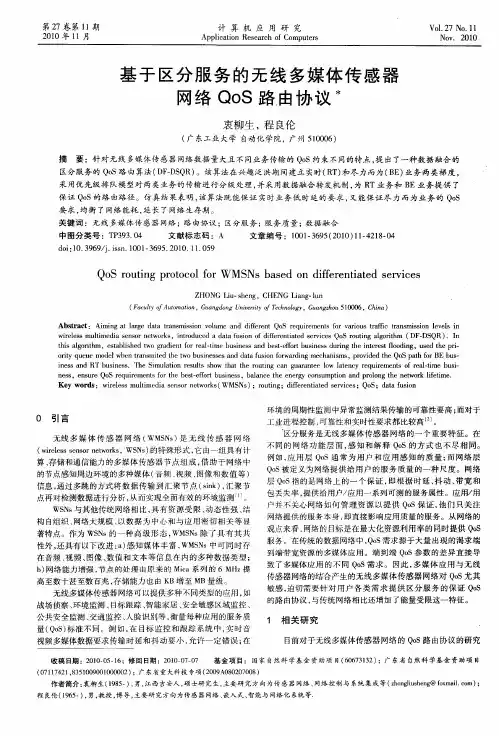

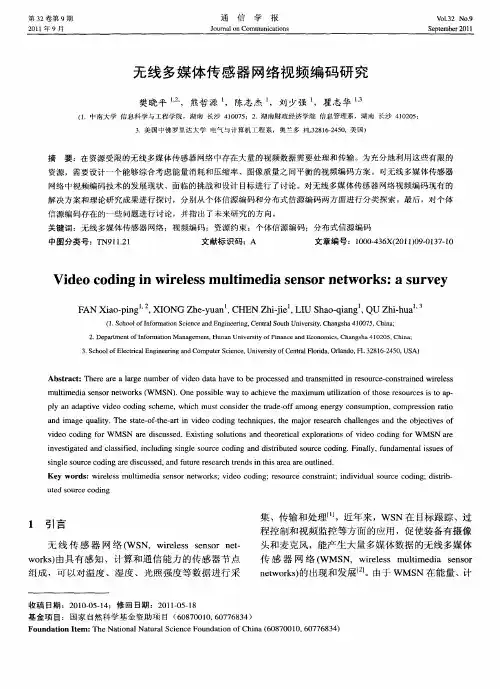
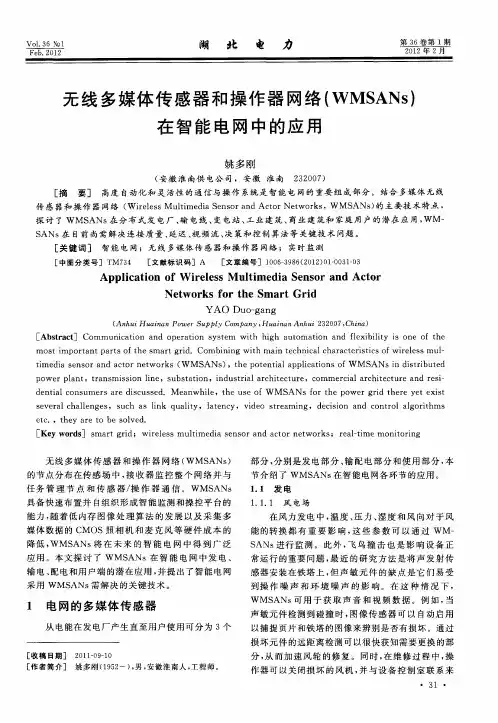
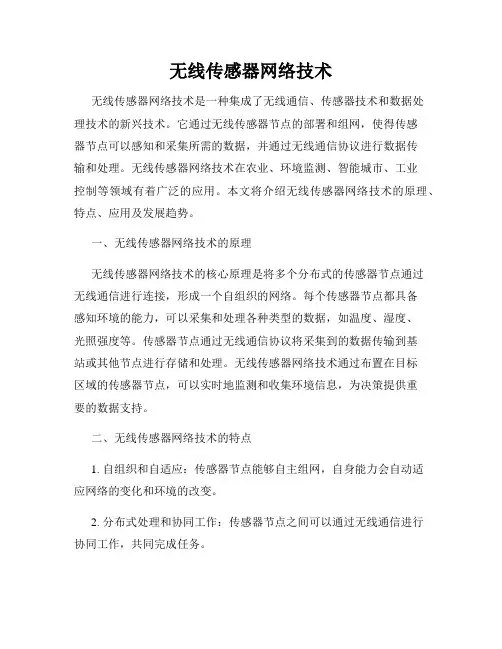
无线传感器网络技术无线传感器网络技术是一种集成了无线通信、传感器技术和数据处理技术的新兴技术。
它通过无线传感器节点的部署和组网,使得传感器节点可以感知和采集所需的数据,并通过无线通信协议进行数据传输和处理。
无线传感器网络技术在农业、环境监测、智能城市、工业控制等领域有着广泛的应用。
本文将介绍无线传感器网络技术的原理、特点、应用及发展趋势。
一、无线传感器网络技术的原理无线传感器网络技术的核心原理是将多个分布式的传感器节点通过无线通信进行连接,形成一个自组织的网络。
每个传感器节点都具备感知环境的能力,可以采集和处理各种类型的数据,如温度、湿度、光照强度等。
传感器节点通过无线通信协议将采集到的数据传输到基站或其他节点进行存储和处理。
无线传感器网络技术通过布置在目标区域的传感器节点,可以实时地监测和收集环境信息,为决策提供重要的数据支持。
二、无线传感器网络技术的特点1. 自组织和自适应:传感器节点能够自主组网,自身能力会自动适应网络的变化和环境的改变。
2. 分布式处理和协同工作:传感器节点之间可以通过无线通信进行协同工作,共同完成任务。
3. 资源受限:传感器节点的能量、存储和计算能力有限,需要进行能量管理和优化设计。
4. 高度部署和灵活性:传感器节点可以大规模部署,根据需求进行灵活的布局。
5. 系统可靠性和安全性:无线传感器网络技术需要具备对数据的可靠传输和隐私的保护能力。
三、无线传感器网络技术的应用1. 农业领域:在农业生产中,无线传感器网络技术可以用于土壤湿度的监测、作物生长的监控、气象数据的采集等。
2. 环境监测:无线传感器网络技术可以用于城市环境的污染监测、水质监测、大气污染的监测等,为环境保护提供数据支持。
3. 智能交通:在交通管理中,无线传感器网络技术可以用于交通流量的监测、交通信号的优化调度等,提高交通效率和安全性。
4. 工业控制:无线传感器网络技术可以应用于工业自动化生产中,实时监测工艺参数、设备状态,提高生产效率和安全性。
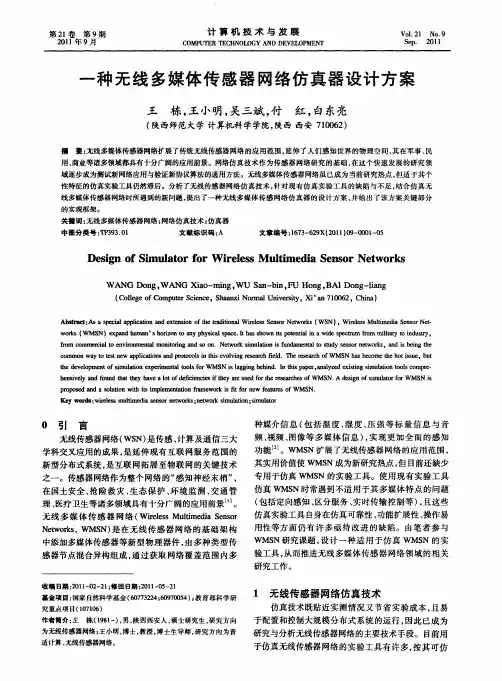
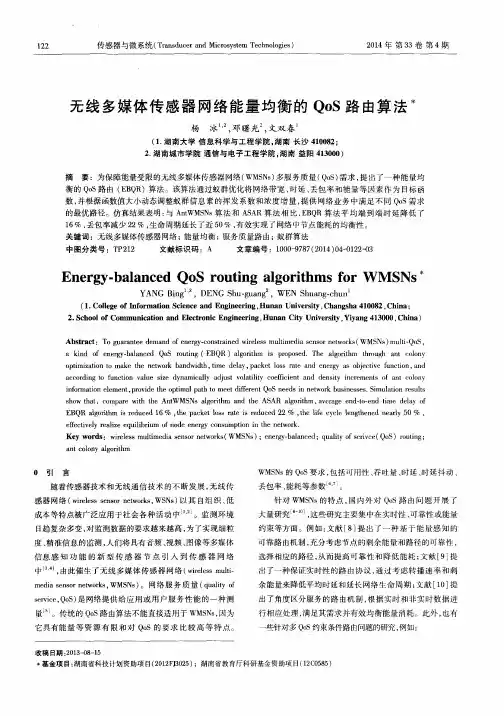
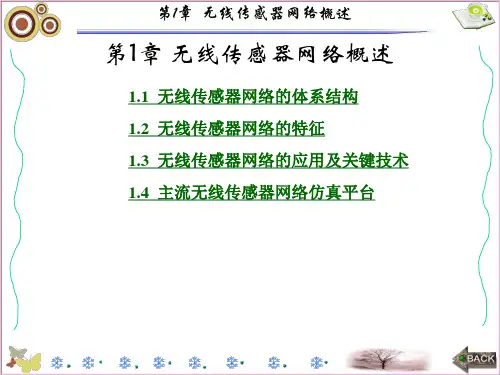

无线传感器网络技术的发展与应用前景1.引言无线传感器网络(Wireless Sensor Network, WSN)是一种由大量分布在空间中的无线传感器节点组成的网络。
随着信息技术和通信技术的飞速发展,无线传感器网络技术得到了大规模的应用和推广。
本文将探讨无线传感器网络技术的发展历程以及其未来的应用前景。
2.无线传感器网络技术的发展历程无线传感器网络技术起源于20世纪80年代中期,在当时被用于军事领域的监测与控制。
随着无线通信技术的不断突破,无线传感器网络的发展进入了一个新的阶段。
1999年,美国的Crossbow公司推出了首个商用无线传感器节点TELSEN,标志着无线传感器网络技术进入商用化阶段。
此后,无线传感器网络技术在农业、环境监测、交通管理、医疗保健等领域得到了广泛的应用。
3.无线传感器网络技术的特点与优势无线传感器网络技术具有以下特点与优势:(1)网络规模大:无线传感器网络可以由大量的节点组成,覆盖范围广,可以应对各种复杂环境下的监测需求;(2)自组织性:无线传感器节点可以自主组网,自适应地进行节点选择和网络重构,具有良好的自组织性;(3)实时性强:无线传感器网络能够实时获取并传输环境数据,可以快速响应和处理事件;(4)低功耗:无线传感器节点采用低功耗的设计,延长了网络的使用寿命;(5)成本低:无线传感器节点的制造成本较低,适应于大规模部署。
4.无线传感器网络技术的应用领域(1)环境监测:无线传感器网络可以用于气象、水质、土壤和大气等环境参数的监测,对环境状况进行实时监控和预警。
(2)农业领域:无线传感器网络可以实时监测土壤湿度、光照强度、温度等农田环境参数,提高农业生产的效益与质量。
(3)智慧城市:无线传感器网络可以用于交通管理、垃圾处理、智能停车等领域,提升城市管理水平和居民生活品质。
(4)物联网:无线传感器网络是物联网的基础,无线传感器节点与其他物联网设备进行连接,实现信息的交互与共享。
1 概述1.1 概念无线多媒体传感器网络是在无线传感器网络中加入了一些采集信息更加丰富的视频、音频、图像等传感器节点,由这些不同的节点组成了具有存储信息、数据计算和通信能力的分布式感知网络。
WMSNS用多媒体传感器节点感知周围环境中的多种媒体信息,这些信息可以通过单跳和多跳中继的方式将数据信息传送到信息的汇聚中心,然后汇聚中心对接收到的数据进行分析处理,最终把分析处理后的结果发送给用户,从而实现了全面而有效的环境监测[34,35]。
广义的无线多媒体传感器网络涵盖了传统数值传感器网络(traditionalscalarsensornetwork)、视频传感器网络(audioandvideosensornetworks)、图传感器网络(imagesensornetworks)、视觉传感器网络(visualsensornetworks)以及视频、音频、图像等各种传感器节点网络的混合[15]。
1.2 研究背景近年来,多媒体传感器网络技术的研究已引起了科研人员的密切关注,holman[1]等人率先提出利用视频传感器网络实现海岸环境监控,DeBardelaben,J.A[2]在2003年11月的国际会议上发表文章提出了无线多媒体传感器网络的概念一些学者开展了多媒体传感器网络方面的探索性研究,在IEEE系列会议(如MASS,ICIP,WirelessCOM等)、ACM 多媒体和传感器网络相关会议(ACM Multimedia,ACM MOBICOM,ACM WSNA等)发表了一些重要的研究成果。
从2003年起ACM还专门组织国际视频监控与传感器网络研讨会(ACM International Workshop on Video Surveillence & Sensor Networks)交流相关研究成果,国内外也有许多高校开始了该领域的探索。
美国加利福尼亚大学、卡耐基-梅隆大学、斯坦福大学等也开始了无线多媒体网络方面的研究工作,纷纷成立了无线多媒体网络组并启动了相应的科研计划。
摘要无线多媒体传感器网络(Wireless Multimedia Sensor Networks,WMSN)是随着半导体技术的发展,在无线传感器网络(Wireless Sensor Networks, WSN)中引入低功耗视频和音频传感器而形成的。
无线多媒体传感器网络由于丰富的传感信息已经成为一个研究热点,被广泛应用于图像注册、分布式视频监控、环境监控以及目标跟踪等项目中。
由于传感器类型的变化,在基于无线多媒体传感器网络的目标跟踪过程中,需要采用不同于传统无线传感器网络的新方法和策略。
本文提出了目标定位方法和基于动态分簇的目标跟踪架构,以提高目标跟踪的性能。
在提出的目标定位方法中,首先分析了无线音频传感器的信号衰减特性和传感器分布位置对目标定位精度的影响,形成目标跟踪的传感器节点选择原则。
然后,分析了现有计算机视觉领域的摄像头标定技术和无线视频传感器节点的特点,利用监控区域有限点的位置坐标,通过CamShift单目标跟踪和双节点的平移特性,求解出摄像头标定的旋转矩阵R与内部参数矩阵K,从而通过视频传感器节点以低复杂度的方法完成了目标定位。
在动态分簇研究中,提出了基于动态分簇的目标跟踪架构,通过设计架构中的动态分簇算法以及路由协议,提高了目标跟踪的鲁棒性和精度,降低了目标跟踪的能量消耗。
动态分簇算法基于运动目标的历史轨迹数据,对目标的将来轨迹和当前速度进行预测。
通过预测结果优化选择簇头和簇半径,并以簇内节点完成目标跟踪。
簇内普通节点完成目标的感知后,将数据发送给簇头。
簇头完成目标定位,再将位置坐标发送给汇聚节点以完成目标跟踪。
为了保证目标跟踪数据传输的可靠性,降低链路的丢包率,基于蚁群算法设计了最小能量消耗率路由协议,对链路的最大负载进行限制。
在具有安全机制的动态分簇协作处理研究中,首先利用节点的自定位功能,提出了基于位置坐标的任务分配算法TAAC。
TAAC以最小的能量消耗为目的,以任务处理的实时性为限制条件,将计算与通信任务分配给目标附近的传感器节点,通过传感器节点的并行计算提高网络的处理能力,降低网络能量消耗。
为了保证协作处理的安全,针对两跳分簇协作处理架构,提出一种新的密钥管理协议。
通过建立簇密钥对,降低了密钥存储开销,解决了密钥对建立和更新过程中通信开销大的问题。
具有安全机制的协作处理的研究,既提高了目标跟踪的实时性,又为网络提供了安全保证。
最后,本文设计并实现了小规模的目标跟踪无线多媒体传感器网络。
主要包括低功耗无线图像传感器节点、无线温度传感器节点和服务器的软硬件设计与实现。
相比现有的同类型传感器节点,本文的节点提高了处理速度和传输带宽,降低了能量消耗。
网络能支持温度和图像数据的多跳传输,错包率低。
无线图像传感器节点感知目标的出现后将图像数据发送给汇聚节点,并通过Shape Matching 算法对目标进行匹配,减少同一个目标数据的重复发送,降低网络的能耗。
关键词:无线多媒体传感器网络,目标定位方法,目标跟踪,动态分簇,任务分配,路由算法,密钥管理,平台设计AbstractWith the development of semiconductor technology, the low power video and acoustic sensors are widely used in the Wireless Sensor Networks (WSN) to foster the Wireless Multimedia Sensor Networks (WMSN).The WMSN becomes a hot research spot for its abundant sensed information and has been applied to applications such as image registration, smart video surveillance, environment monitoring and target tracking.Due to the difference of sensors, the new method and strategy are needed in the target tracking based on the WMSN. This paper has proposed the localization method and the target tracking architecture based on dynamic clustering to promote the performance of target tracking.In the proposed target localization method, the characteristics of the attenuation of audio signal and the impact of target localization precision affected by sensor positions have been analyzed to get the nodes selection principle. Then, the camera calibration technologies in computer vision area and the characteristics of wireless video sensors have been analyzed. Through the coordinates of several points in the field of view, based on the CamShift and the two nodes in a parallel model, the new calibration algorithm solves the rotation matrix R and interior parameter matrix K. Then, the target localization has been carried out by the low-complexity method base on wireless video sensors.In the research of dynamic clustering, the architecture for target tracking based on dynamic clustering is proposed. The dynamic clustering algorithm and routing protocol have been designed to improve the robustness and precision of target tracking performance. The energy consumption has been reduced as well. In the dynamic clustering algorithm, with the history target coordinates, the direction and the speed of the target is forecasted. Based on the forecasted results, the cluster head and radius are optimized. The cluster members detect the target and send the results to the cluster head at which the target localization are carried out and send to the Sink. In order toensure the reliability of data transmission and reduce the packet lost ratio, a Minimum Energy Consumption Ratio Routing Protocol based on Ant Colony is proposed and the maximum load of the path is constrained as well.In the research of cooperative processing with secure mechanism in the dynamic clustering, the task allocation algorithm based on coordinates (TAAC) is proposed. The TAAC, which takes the minimum power consumption as optimization target and the real-time as constraints, allocates the computation and communication tasks to the nodes near the target. The sensor nodes promote the processing power by computing in parallel. In order to guarantee the security of cooperative processing, a key management protocol for two hop clustering structure is proposed. Through creating the cluster key, the protocol reduces the key storage cost and resolves the problem of high communication cost for key distribution and renewing. The research of cooperative processing with secure mechanism not only promotes the real-time performance, but also guarantees the network security.In the last chapter, a small-scale target tracking wireless multimedia sensor networks has been designed and implemented. The hardware and software of low power wireless image and temperature sensor nodes, as well as the software of the server, have been carried out. Compared with the existing sensor nodes, the processing power and bandwidth have been promoted and the energy consumption has been reduced. The wireless multimedia sensor networks can transmit temperature and image data in multi-hop model with low packet error ratio. The wireless image sensor can detect the target and send the image data to the server. In order to avoid transmitting the image of the same target and reduce the energy consumption, the wireless image sensor matched the targets by Shape Matching Method.Keywords: Wireless Multimedia Sensor Networks, Target Localization Method, Target Tracking, Dynamic Clustering, Task Allocation, Routing Algorithm, Key Management, Platform Design.。